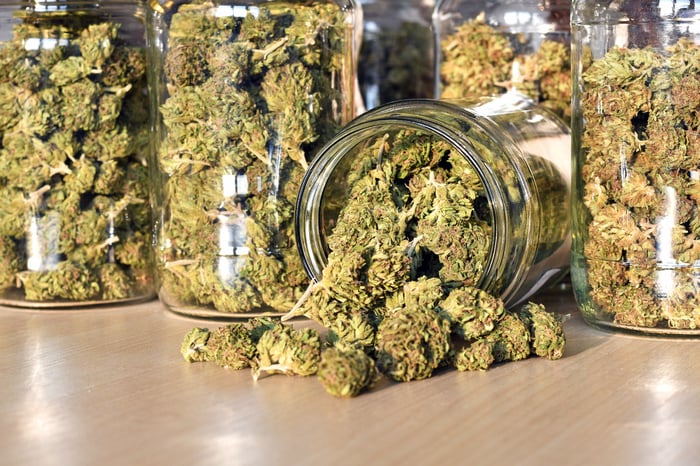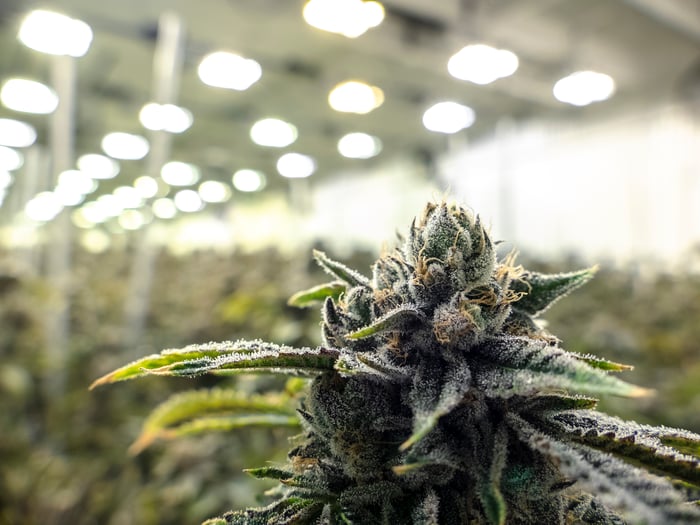The marijuana industry is absolutely growing by leaps and bounds, and Wall Street has had no choice but to take notice. Since 2016, a majority of pot stocks have seen their valuations soar by a triple- or quadruple-digit percentage, with none racking up the gains quite like Canopy Growth (CGC -0.66%).
Today, Canopy Growth is the largest publicly traded pot stock in the world, with a market cap of just shy of $15 billion. This also makes it the only marijuana stock with a true large-cap valuation, albeit Aurora Cannabis is closing in with a market cap of $9 billion.

Image source: Getty Images.
Canopy Growth keeps a lid on its cultivation potential
Though there are a number of factors that have propelled Canopy Growth to its industry-leading valuation, such as its well-known Tweed brand, multiple sales channels, domestic supply deals, and product diversification, it's arguably the company's production potential that has the market most excited. Yet, the interesting thing about this company is that it tends to be pretty tight-lipped about its grow farms and what they're capable of when running at full capacity.
In the company's fiscal third-quarter operating results, released in mid-February, we learned that more than 4.3 million square feet of the company's targeted 5.6 million square feet of production space had been licensed by Health Canada, with the expectation that the full complement of growing space will be given the green light for planting before the end of the calendar year.
However, this doesn't tell investors a whole lot about what the company's domestic production capacity actually looks like. In order to find out details on its domestic grow farms, we have to dig all the way back to Canopy's fiscal first-quarter management discussion and analysis document, filed with SEDAR in Canada this past August. This document provides the most recent update of what Canopy is working with in terms of growing space. Although the size of the cultivation space has been rounded for simplicity (meaning it won't equal the aforementioned 5.6 million square feet that Canopy continually touts), this provides the clearest picture of how the company can easily surpass 500,000 kilos of peak annual output.

Image source: Getty Images.
An inside look at Canopy's path to more than 500,000 kilos of annual production
The following grow farms are wholly owned by Canopy Growth:
- Delta, British Columbia: This roughly 1.7 million-square-foot facility is a hybrid greenhouse -- i.e., it combines a controlled greenhouse environment with the benefits of full spectrum sunlight and field growing -- with a post-harvesting processing center.
- Aldergrove, British Columbia: With more than half of its grow space in British Columbia, this 1.3 million-square-foot farm is also a hybrid greenhouse with onsite processing.
- Niagara-on-the-Lake, Ontario: Similar to the grow farms above, this 1 million-square-foot grow farm is a hybrid greenhouse with post-harvest processing done on site.
- Smiths Falls, Ontario: This is arguably Canopy's most diverse grow farm, with indoor cultivation, post-harvest processing, as well as oil extraction, distribution, and even a visitor center, spanning approximately 730,000 square feet.
- St. John's, Newfoundland & Labrador: As is the case with most of Canopy's smaller facilities, this 150,000-square-foot space is devoted to indoor growing and on-site processing. It also handles retail cannabis sales.
- Edmonton, Alberta: Similar to St. John's, this 100,000-square-foot facility is an indoor grow space with onsite post-harvest processing.
- Bowmanville, Ontario: Moving down the line, Bowmanville offers 75,000 square feet for indoor growing with (no surprise) post-harvest processing onsite.
- Yorkton, Saskatchewan: Ever smaller, Yorkton is home to 60,000 square feet of cultivation space that comes complete with post-harvest processing.
- Fredericton, New Brunswick: This recently licensed indoor grow farm features 50,000 square feet of space and the ability to process onsite.
- Scarborough, Ontario: This is yet another 50,000-square-foot indoor grow space with devoted onsite processing.
- St. Lucien, Quebec: This tiny tot of the bunch spans just 10,000 square feet and will be solely used for indoor breeding.

Image source: Getty Images.
And here are Canopy's controlled or partnered grow farms:
- Mirabel, Quebec: This is a 700,000-square-foot farm that is controlled by Canopy. As with every site, save for St. Lucien, it has post-harvest processing, and, like the other large cultivation farms above, is of the hybrid variety.
- Creemore, Ontario: The Creemore campus is partnered, with a 40% ownership stake belonging to Canopy Growth. In total, this farm spans 15,000 square feet, with a focus on indoor growing, processing, and oil extraction.
Again, these facilities may not add up perfectly to the 5.6 million square feet the company mentioned in its third-quarter report, but that's most due to rounding and the company keeping a tight lid on production.
Making sense of the data
So, how does Canopy Growth get to 500,000-plus kilos of peak production per year with this puzzle of grow farms above? The simple answer is that it five biggest facilities will do most of the work.
Throughout the industry, the average yield per square foot is about 100 grams. Given Canopy's listed space, this should yield around 560,000 kilos a year. But it's not that simple. Remember that not every square inch of the space listed above is devoted to growing. At least some square footage is set aside for processing, or perhaps even extraction or alternative products in select farms. This makes the smaller farms icing on the cake for Canopy.
Meanwhile, its five largest farms -- Delta, Aldergrove, Niagara-on-the-Lake, Smiths Falls, and Mirabel -- will yield the bulk of its production. Courtesy of economies of scale, all five of these facilities would be expected to produce north of 100 grams per square foot. It's these farms that have yours truly thinking that Canopy Growth will likely produce closer to 525,000 kilos a year, behind only Aurora Cannabis' 700,000 kilos at peak production.
Obviously, production isn't everything with pot stocks. But with Canopy already boasting a number of competitive advantages, a high amount of output certainly isn't hurting its valuation.





